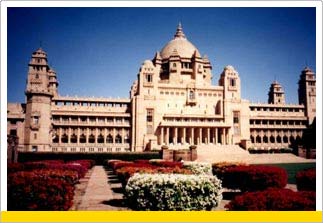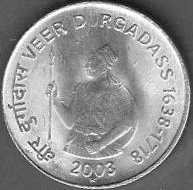| Coins in Memory of Veer Durgadass Rathore |
| Deputy Prime Minister, Shri L.K. Advani released commemorative coins in the memory of Veer Durgadass, the great warrior of Rajasthan on 25th August 2003. The Denominations of the Coins are Rs. 100, Rs. 10 and Re. 1. The Re. 1 coin will be for circulation. One side of the coin bear the portrait of VEER DURGADASS and the other side has 'Ashoka Emblem' |
| History of Rathores |
| The martial clan of Rathores, ruled Marwar from Jodhpur. Rathores were decedents of Jaichand of Kanauj, who was defeated by Muslim invader, Mohammed Ghori in 1194. Mandore is Marwar's most historic city. Legend has it that Ravana, the Demon King of Lanka who defied Lord Rama himself, married a princess of Mandore, his favourite queen Mandodri. In 1292 the PariharRajputs lost Mandore to the Khilji Sultans of Delhi.� In 1395, their Governor Aibak Khan, demanded fodder as well as the tax on grain, and this eventually proved to be his undoing. |
| Mehrangarh |
| It was left to Chunda's grandson, RaoJodha, to secure a place for the Rathores in the annals of India by building one of her most spectacular forts and founding one of her most charming cities. The foundation of this fort was laid on 12 May 1459 by Jodha himself. Jodha had a young man buried alive in it to ensure the new site proved propitious. This man was Rajiya Bambi who was promised that his family and descendants would be looked after by the Rathores. It is a promise that has been honoured and Rajiya's descendants, who still live in RajBagh, Rajiya's Garden; the estate bequeathed to their ancestor by Jodha, continue to enjoy a special relationship with the Maharaja. |
| As the Rathores grew more powerful, Mehrangarh, at once a reflection of their glory and the basis of their strength, expanded. Its towering battlements, a hundred and twenty feet high, and stone walls, in places six metres thick, testify to the might of Maldev (1532-1562) in whose reign the Rathores reached the zenith of their power. The main gates, FatehPol and Jai Pol, sing of great victories, against the Mughals in 1707 and the Jaipur forces a hundred years later; while the ramparts, fiercly brandishing Maharaja Abhaya Singh's cannons (1724-1749), proudly proclaim these victories to the world. |
| Jodhpur |
| Mehrangarh he built for his clansmen; for his subjects Jodha founded a city, a city he named simply, Jodhpur, Jodha's City. Like other medieval cities of consequence, Jodhpur was originally a walled city too, and Jodha's walled Jodhpur had four Pols or gates, three of which still stand, though not in very good condition. In tribute to the stability and prosperity of her founder's reign (1438-1488), Jodhpur outgrew her original walls within fifty years of his death. � |
| War with Moghuls |
| In 1527, RaoMaldev, (nineteenth Rathore) commanded the Rathore cavalry to the plain of Khanua, forty miles from Agra, against the Mughal invader Babur. The Rajput Confederacy there was defeated and the Battle of Khanua all but established Babur as the Emperor of India. But the first Mughal emperor died only three years later, and taking advantage of the disorder in Delhi, Maldev, who succeeded his father in 1532, launched his clan into a decade of unrestrained expansion. By 1540 he held sway over more than a hundred thousand square miles of territory. Delhi was only fifty miles away and all of Rajputana had been subdued. It was the high noon of Rathoree Raj, the glory of that decade still exciting the imagination of the Rathore today. |
| War with Sher Shah |
| It was in 1540 that Sher Shah the Afghan defeated Babur's son and successor, Humayun, who fled to Sind (now in Pakistan) after a brief halt in Marwar at Maldev's invitation. Sher Shah, requested Maldev to capture Humayun, but Maldev let him go. Shershah was furious. In the winter of 1543 the Afghan brought his army of eighty thousand to Marwar. The Rathore army of fifty thousand was defeated in a close battle. The defeat lead to Jodhpur and Mehrangarh's first occupation. Maldev returned only after Sher Shah was killed in a freak accident a year later. And though he was able to recover most of Marwar he was never again more than a shadow of his former self. |
| Moghul Age in Marwar |
| Two years after he died, in 1564, the twenty-one-year-old Akbar, the third Mughal emperor, invaded Marwar and occupied Mehrangarh and Jodhpur again; the second occupation. This did not break the spirit of Maldev's son and successor, Rao Chandra Sen, who remained free and independent, for all it was worth, till he died in 1581. Two years after he died, his unpopular brother Udai Singh acceded to the Gadi or throne of Marwar with Akbar's blessings. Thus began the Mughal era inMarwar. In 1678, when Maharaja Jaswant Singh I died in Afghanistan and Aurangzeb invaded Marwar, the Rathores happily demonstrated to the world, perhaps even to themselves, that they could still fight. |
| Durga Dass Rathore |
| Jaswant Singh I died without an heir but two of his queens were pregnant and it was around the elder baby, Ajit Singh, born a few months later, that the clan now rallied, displaying a degree of resilience and loyalty unsurpassed in history.This period, from 1678 to 1707, The Thirty Year Rathore War of Independence, is one of the most glorious chapters in the history of the clan and it produced its greatest hero, DurgaDasRathore. It was DurgaDas, a Thakur, who protected the infant Ajit and challenged Aurangzeb for twenty five of those thirty years. The war of independence also produced a heroine, Gora Dai, Ajit's wet-nurse, who smuggled him out of Delhi in a basket when Aurangzeb had the Rathorehaveli surrounded. She left behind her own child so that the Emperor's spies would continue to hear an infant's cry in the haveli. |
| By the turn of the seventeenth century DurgaDas had recovered most of Marwar but Jodhpur itself was regained only a few days after Aurangzeb's death in 1707.Before entering their citadel Ajit Singh and DurgaDas had Mehrangarh washed clean with sacred water from the River Ganga And to commemorate their re-conquest the ecstatic Ajit built the FatehPol, the Gate of Victory in the fort which opens out into the walled city. |
| In the twilight of the Mughal era Maharaja Ajit Singh rose to great prominence and power in Delhi, placing on Shah Jahan's Peacock Throne as many as five puppet emperors. But he died in a most brutal and foul manner. In 1724 he was murdered by his second son Bakhta Singh as he lay asleep in his chamber in Mehrangarh. The motive in all likelihood was political ambition for he was granted the district of Nagaur soon after by his brother, the new Maharaja Abhaya Singh. The Rathores would take many years to recover from this monstrous act and when they finally did, it was too late. |
 |
| The Parihars, tired of this autocratic man, hatched a plan, which, in ingenuity matched the famous Trojan Horse, and in bravery far surpassed it. Five hundred Parihars smuggled themselves into the fortified city in a hundred cart-loads of grass. These carts were checked randomly and prodded with spears. Some men were pierced but they uttered not a sound and, in fact, even managed to wipe the blood off the spears as they were withdrawn. Then the Parihars fell upon the Muslims. Within an hour Mandore was once again in their hands but the victors realised that defending her was going to be an entirely different problem. It was then that someone suggested a marital alliance be arranged with the young Rathore Rao Chunda. Thus did Mandore, the capital of Marwar, come to the Rathores in a dowry. |
 |
 |
| With the birth of Mehrangarh and Jodhpur, the Rathores entered their Golden Age. Their conquests were prolific and the farsighted Jodha settled his brothers and sons in the new lands as the Thakurs or feudal lords. In 1488 when Jodha died and� Jodha was succeeded by his son RaoSatal (sixteenth Rathore chief). ��He died in 1492 rescuing a hundred and forty village maidens who had been abducted by Muslim invaders. |
 |
 |
| Majestic Mehrangarh Fort |
| Ummaid Bhawan Palace |
| Queens Cenotaphs Mandore |
 |
| A picture of coin release function |
 |
| One Rupee Coin on Durgadass Rathore |